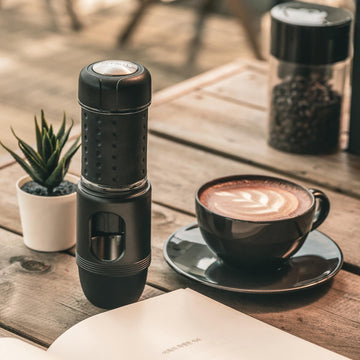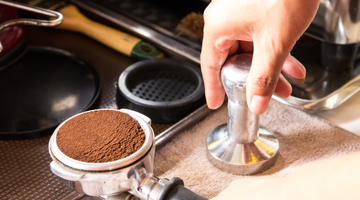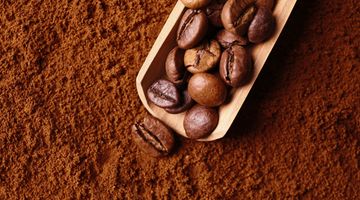Ever wondered why your espresso shots aren't quite hitting the mark? A crucial step that often gets overlooked is tamping. If you've been scratching your head over how to tamp espresso properly, you're in the right place. Let's break down this essential skill in a way that's easy to follow so you can enjoy café-quality espresso right at home.
What is tamping?
First things first: why do you tamp espresso? Tamping is the process of compressing the coffee grounds in the portafilter to create a level bed. This ensures that water flows evenly through the coffee during extraction, leading to a balanced and flavorful shot. Without proper tamping, water can find the path of least resistance, leading to uneven extraction and a less-than-ideal cup of coffee.
Tools needed for tamping espresso

Before we dive into the how-to, let's talk about the tools you'll need:
-
Tamper: A device used to press the coffee grounds. Tampers come in various styles, including flat, convex, and calibrated.
-
Portafilter: The handle and basket assembly that holds the coffee grounds during brewing.
-
Flat Surface: A stable surface to press against, ensuring even pressure.
Having the right tools makes all the difference. If you're looking for a reliable tamper, consider checking out this one from STARESSO.
Step-by-step guide to tamping espresso
Step 1: Preparing the portafilter
Start by distributing the coffee grounds evenly in the portafilter. This is crucial because an uneven distribution can lead to uneven extraction.
Give the portafilter a gentle shake or lightly tap it on the counter to level the coffee grounds. Make sure the coffee is evenly spread before you start tamping.

Step 2: Applying the tamp
Now, let's get into the nitty-gritty of how to tamper espresso.
Place the tamper level on top of the coffee grounds. Your goal here is to apply even pressure across the entire surface.
Apply firm, even pressure, to compress the grounds. Aim for about 30 pounds of pressure. This might sound a bit abstract, but with practice, you'll get a feel for it. If you're using a calibrated tamper, it will click when you've applied the right amount of pressure.
You don't need to press down with all your might. Consistency is more important than sheer force. Too little pressure can lead to under-extraction, while too much can cause over-extraction.
Step 3: Polishing the puck
After applying the initial tamp, give the tamper a gentle spin. This helps to smooth out the surface of the coffee grounds, known as "polishing the puck."
Lightly twist the tamper while still applying slight pressure. This polishes the coffee puck, creating a uniform surface for water to flow through.
Common tamping mistakes and how to avoid them
Uneven tamping
One of the most common mistakes is applying uneven pressure, which can lead to channeling. This is when water finds weak spots in the coffee bed, leading to an imbalanced shot.
Always make sure the tamper is level and apply even pressure. Practice makes perfect, and a bit of mindfulness goes a long way.
Applying too much or too little pressure
Can you over-tamp espresso? Absolutely. Too much pressure can compact the coffee grounds too tightly, making it hard for water to pass through. Conversely, too little pressure results in a loose puck that water will rush through too quickly.
Aim for about 30 pounds of pressure. Use a calibrated tamper if you're unsure about your tamping strength.
Not polishing the puck
Skipping the polishing step can result in a less smooth surface, which affects extraction.
Always give the tamper a slight twist after tamping. It only takes a second but makes a significant difference.
Benefits of proper tamping
Enhanced flavor and aroma
Proper tamping ensures that water extracts the coffee evenly, enhancing the flavor and aroma of your espresso. This means a more balanced shot with all the nuanced flavors of the coffee coming through.
Consistency in shots
Once you nail down how to tamp espresso correctly, you'll achieve more consistent shots. Consistency is key to making great espresso, whether you're brewing for yourself or impressing friends.
Maximizing the performance of your equipment
Proper tamping helps you get the most out of your espresso machine. It ensures that your equipment works efficiently, producing the best possible shot every time.
Tamping tips for portable espresso machines

Portable espresso machines, like the STARESSO Classic, offer the convenience of great espresso on the go. Here are a few tips specific to tamping with portable machines:
-
Distribute Evenly: Since portable machines often have smaller portafilters, make sure to distribute the grounds as evenly as possible.
-
Consistent Pressure: Apply consistent pressure, just like you would with a standard machine. The principles of how to tamper espresso remain the same.
Perfect your tamping technique
Tamping might seem like a small step, but it's crucial for making excellent espresso. By mastering how to tamp espresso, you'll ensure even extraction, balanced flavors, and a consistently great cup every time. Remember to distribute your grounds evenly, apply consistent pressure, and polish the puck for the best results.
Ready to upgrade your espresso game? Explore quality tampers and accessories to enhance your coffee experience. With a bit of practice and the right tools, you'll be pulling perfect shots in no time.
Frequently asked questions on how to tamp espresso
How hard to tamper espresso?
Apply about 30 pounds of pressure when tamping espresso. Consistent pressure is key to avoiding under or over-extraction.
Can you over-tamp espresso?
Yes, over-tamping can compact the coffee grounds too tightly, making it difficult for water to pass through and leading to over-extraction.
Why do you tamp espresso?
Tamping compresses the coffee grounds to ensure even water flow during extraction, resulting in a balanced and flavorful espresso shot.
How to tamper espresso correctly?
Distribute the coffee grounds evenly, apply firm and even pressure with the tamper, and polish the puck by giving the tamper a slight twist.
What tools do I need to tamp espresso?
You'll need a tamper, a portafilter, and a flat surface. High-quality tampers and portafilters, like those from STARESSO, can improve your tamping results.








